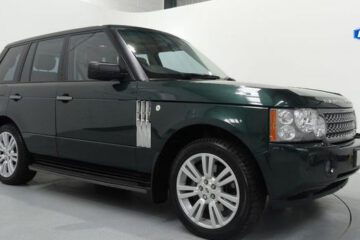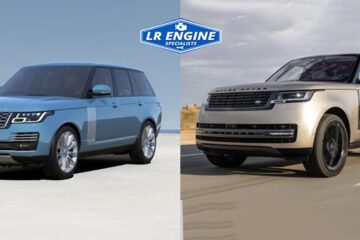When exploring the best luxury SUVs, a comparison of the Range Rover 4.2 V8 engine is necessary to assess its capabilities. Over the decades, Range Rover has developed a mixed range of petrol and diesel engines that offer power, efficiency, and refinement. From early normally aspirated engines to the more advanced supercharged V8s, Land Rover’s innovation has never come to an end. Among all these, the Range Rover Vogue 4.2 engine stands as a legend. Whether cruising smoothly or tackling rugged terrain, the 4.2 V8 guarantees that the journey is just as remarkable as the destination.
The Benchmark: The Range Rover Vogue 4.2 V8 Engine
The Range Rover Vogue 4.2 V8, supercharged petrol engine introduced during the third generation of Range Rovers, especially the L322 model lineup. This 4.2-litre V8 powerplant was designed to integrate relentless power delivery with a superior luxury driving experience.
With a displacement of 4196cc, the engine generates approximately 400 horsepower and 420 lb-ft of torque. It is coupled with a smooth ZF six-speed automatic gearbox, allowing effortless transitions and controlled acceleration.
Range Rover 4.2 V8 engine comparison often shows how it brings in a level of performance once set for sports cars, now available in a full-size luxury SUV. The engine achieves 0-60 mph in just 7 seconds, a noteworthy figure considering the weight and size of the vehicle.
Comparing with Other Petrol Engines in the Range Rover Lineup
Early Petrol V8s (3.5 to 4.6 V8)
The original Range Rover engines, such as the 3.5L and 3.9L V8s from the Classic period, offered between 135 to 200 horsepower. These were normally aspirated engines that valued reliability over raw performance.
The later 4.6L V8 increased output, but when doing a Range Rover 4.2 V8 engine comparison, it becomes noticeable that the supercharged unit delivers impressively more torque, better acceleration, and superior responsiveness across RPM ranges.
5.0L Supercharged V8 (AJ133)
The 5.0L AJ133 supercharged V8 replaced the 4.2L in later L322 and L405 models. Generating up to 510 horsepower and 461 lb-ft of torque, it may appear to exceed the 4.2 V8 on paper.
However, the Range Rover 4.2 V8 engine comparison reveals that the 4.2L variant offers a more linear power curve and a little bit more refined driving experience, especially admired by purists who value immediate throttle response over raw speed.
Ingenium Petrol Engines (2.0L to 3.0L)
In more recent models, Range Rover accepted Ingenium petrol engines ranging from 2.0L turbocharged four-cylinders to 3.0L inline-six mild hybrids. These engines emphasize fuel efficiency and emissions reductions.
In a Range Rover 4.2 V8 engine comparison, these engines feel less interesting for performance-driven drivers. While technologically the latest, they lack the emotional exhaust note, immediate throttle, and authoritative road presence of the 4.2 V8.
Diesel Variants: A Different Ballgame
TDV6 and SDV6 Engines
The TDV6 and SDV6 diesels, ranging from 2.7L to 3.0L, became famous for their balance of efficiency and torque. These engines perform perfectly in urban environments and on long-distance drives, delivering decent mileage.
In a Range Rover 4.2 V8 engine comparison, its performance and dynamic tackling may fall slightly short of what some other luxury SUVs offer. The diesel clatter, while subdued in the latest models, cannot align with the silky growl of the 4.2 petrol V8.
TDV8 Engines (3.6L and 4.4L)
The 3.6L and 4.4L TDV8 diesel engines are more goal-oriented, with torque figures surpassing 500 lb-ft. These are robust engines by diesel standards, offering strong mid-range acceleration.
Despite their torque-rich nature, the Range Rover 4.2 V8 engine comparison still leans in favour of the 4.2 due to its immediate throttle response and more spirited driving characteristics.
Ingenium Diesel Engines
The latest Ingenium diesel units offer clean emissions and better fuel economy. However, these engines are enhanced for economy rather than driving thrill. Compared to the 4.2 V8, they feel reserved, lacking the natural appeal that petrol power provides.
Real-World Driving Experience: 4.2 V8 vs All Others
From a driver’s seat standpoint, the Range Rover Vogue 4.2 engine delivers a well-balanced blend of power, refinement, and acoustics. The engine note is a deep, mellow growl that improves the premium feel of the cabin.
Petrol alternatives such as the 5.0L V8 may be louder and more aggressive, but they can feel overbearing in comfortable cruising situations. Diesel engines, while efficient, don’t give the same level of emotional engagement.
While conducting a Range Rover 4.2 V8 engine comparison, one observes that this engine hits the sweet spot, providing sufficient power to be thrilling without becoming unrefined or jarring.
Reliability and Maintenance Considerations
The 4.2 V8 is generally regarded as a potent engine. With meticulous maintenance, it can clock well over 150,000 miles without notable issues. Supercharger servicing and cooling system checks are necessary, but predictable and manageable. Compared to earlier V8s, it is more durable due to better materials and engineering. Newer engines such as the 5.0L V8 and Ingenium units, though potent, can be complex and high-priced to repair, especially as electronics play a vital role in engine management.
From a Range Rover 4.2 V8 engine comparison standpoint, this engine provides a strong reliability-to-performance ratio.
Environmental and Efficiency Perspectives
The 4.2 V8 is not the most fuel-saving engine in the Range Rover family. It averages approximately 18 mpg combined, which is bearable for a supercharged V8 but lags behind smaller petrol and diesel engines.
However, emissions compliance during its time was good, and it set the stage for Range Rover’s transition to cleaner engines. While comparing with modern units, specifically Ingenium, the efficiency gap is noticeable.
Still, many enthusiasts discuss that the Range Rover 4.2 V8 engine comparison is more about experience and less about efficiency. For them, the joy of driving outweighs the added price at the pump.
Off-Road Performance Analysis
Despite being a luxury-focused engine, the 4.2 V8 performs impressively off-road. The immediate torque from the supercharger aids in rock crawling and steep climbs. It works well with Range Rover’s Terrain Response system.
In contrast to diesel engines, which deliver higher low-end torque, the 4.2 compensates with immediate throttle modulation and faster power delivery. Even if navigating mud, snow, or sand, the Range Rover 4.2 V8 engine comparison proves it to be a capable and versatile off-road performer.
Tuning and Aftermarket Support
The aftermarket for the 4.2 V8 is strong. Owners can choose ECU tunes, exhaust upgrades, and pulley mods to increase power beyond 450 hp. These upgrades are relatively safe if done expertly.
Other engines, especially diesel units, also offer tuning potential, but they often come with emissions issues and long-term durability questions. In the Range Rover 4.2 V8 engine comparison, petrol tuning is simpler and rewarding.
Engine Sound and Driving Feel
The auditory experience of the 4.2 V8 is among its favorite traits. A throaty roar on acceleration and a gentle hum at cruising speeds create a pleasurable sound profile.
Diesel engines, even the latest TDV8s, lack this emotional resonance. The newer Ingenium petrol units, though refined, do not raise the same passion.
In the Range Rover 4.2 V8 engine comparison, enthusiasts continuously favor the 4.2 for the unmatched driving experience it offers, making every journey feel exciting and powerful.
Conclusion:
After assessing all petrol and diesel alternatives, it becomes clear that the Range Rover 4.2 V8 engine comparison favours the 4.2 for its balance of power, advancement, and emotional engagement. It may not be the most efficient or advanced, but it provides an authentic Range Rover experience that few engines can replicate.
The 4.2 supercharged engine shows a golden era where performance and luxury coexisted without sacrifice. Even if you’re a collector, enthusiast, or simply an aficionado of fine engineering, the 4.2 V8 deserves its pedestal.
For professional maintenance, upgrades, and specialist advice on this legendary engine, LR Engine Specialists remains your reliable partner. With years of experience and a deep understanding of Range Rover powertrains, they offer matchless service and insight into making the most of your Range Rover Vogue 4.2 V8.
FAQs:
How potent is the Range Rover Vogue 4.2 V8 engine?
The 4.2 V8 produces 400 horsepower and 420 lb-ft of torque, delivering strong performance for a luxury SUV.
How does the 4.2 V8 compare to the 5.0L supercharged V8?
While the 5.0L V8 offers more horsepower (510 hp), the 4.2 V8 provides an effortless, more linear power delivery preferred by enthusiasts.
What is the fuel efficiency of the Range Rover Vogue 4.2 V8?
The 4.2 V8 averages approximately 18 mpg combined, which is normal for a supercharged engine in a luxury SUV.
Is the 4.2 V8 engine reliable?
Yes, with meticulous maintenance, the 4.2 V8 can easily last over 150,000 miles, and it has fewer reliability issues compared to older engines.
How does the 4.2 V8 perform off-road?
The 4.2 V8 offers incredible off-road performance, especially with its instant torque delivery and compatibility with the Terrain Response system.


